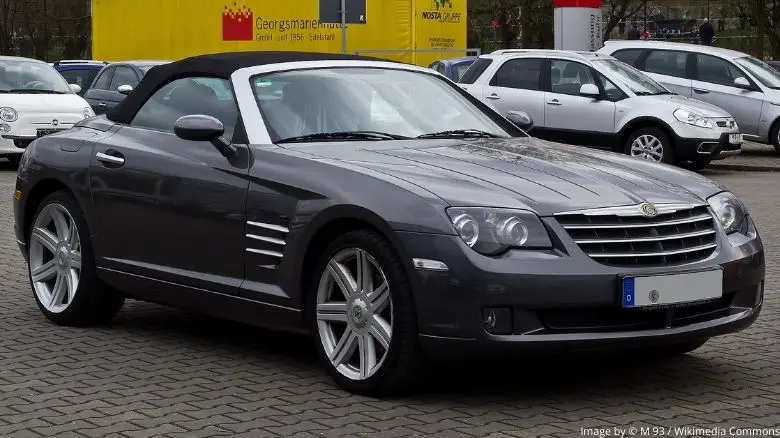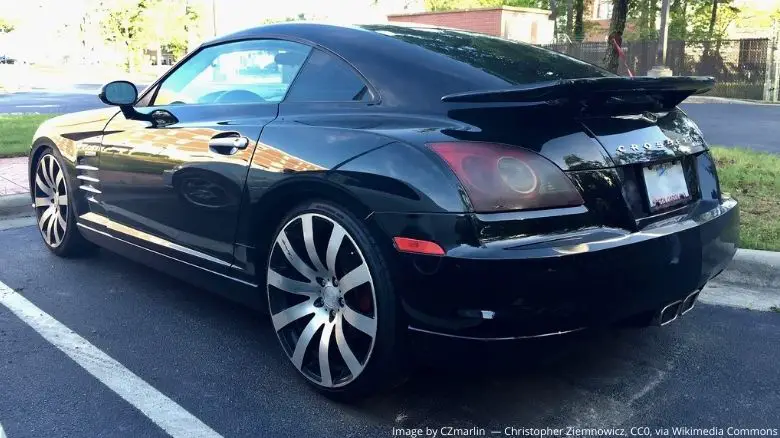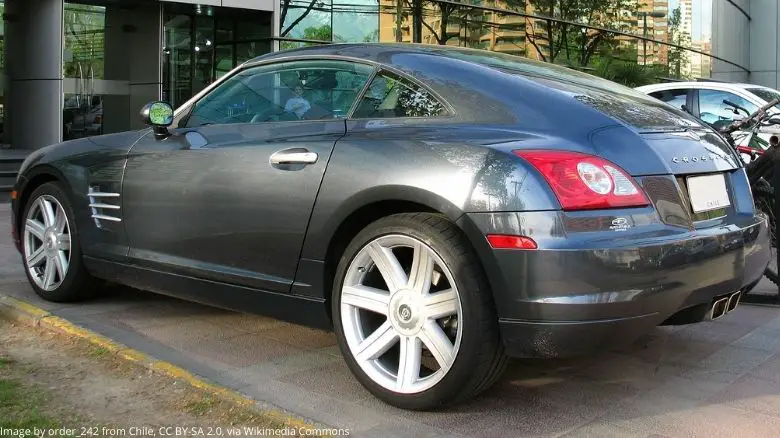Will the Chrysler Crossfire Become a Classic?

Adam Chinn
Founder, The Car Investor
Whether a car becomes a classic or not is a difficult thing to predict. Sometimes cars that are initially rejected by enthusiasts end up becoming classics simply because of their rarity and quirky features.
The Chrysler Crossfire is a car that was considered controversial in the car enthusiast community for a variety of reasons, but these days it has a growing fan base.
So will the Chrysler Crossfire become a classic?
It is possible that the Chrysler Crossfire will become a classic thanks to its relative scarcity and unmistakable design. The high performance SRT6 model and the rarer manual models are more likely to become collectible.
So we know that the Crossfire is likely to become a future classic, but what sort of performance does it have, and is it expensive to maintain?
Is a Chrysler Crossfire considered a sports car?
The Chrysler Crossfire can be considered a sports car as it possesses all the main ingredients: a 2-door coupe design, decent performance, and sporty handling characteristics.
Sports cars often achieve classic status, though the term 'sports car' remains open to interpretation. Most enthusiasts and insurance companies would agree that the Crossfire qualifies as a sports car based on its fundamental design philosophy.

Sports cars prioritize performance over practicality, and the Crossfire certainly wasn't produced to offer family-friendly utility. Despite some criticism regarding the base model's power output, it features the classic sports car formula: two doors, two seats, front-mounted engine, and rear-wheel drive.
The regular model included genuine sports car features such as an active rear wing, though the interior quality and handling dynamics received mixed reviews from contemporary critics. These perceived shortcomings, however, often become irrelevant as cars transition into classic status.
Is the Crossfire a Mercedes?
Advertisement
The Chrysler Crossfire is essentially a remodeled Mercedes SLK, sharing approximately 80% of its components with the German car while Chrysler handled the distinctive exterior styling.
Production took place under DaimlerChrysler's ownership (before the companies separated) at Karmann's facility in Osnabrück, Germany. This German production ensures the build quality standards that support long-term reliability and classic car viability.
The Crossfire utilizes Mercedes-Benz's proven M112 engine, the same powerplant fitted to the first-generation Mercedes SLK (R170). This mechanical relationship provides access to Mercedes' extensive parts network and engineering excellence, crucial factors for long-term classic car ownership.
Chrysler Crossfire performance
How much horsepower does a Chrysler Crossfire have?
The standard Crossfire's 3.2-liter V6 produces 215 horsepower, while the high-performance SRT6 variant generates 330 horsepower from its supercharged engine.
Chrysler Crossfire 0-60
The standard Crossfire achieves 0-60 mph in 6.5 seconds, respectable for its era, while the SRT6 dramatically improves this to 5.1 seconds, placing it firmly in serious sports car territory.
What is the top speed of a Chrysler Crossfire?
Both variants feature electronically limited top speeds of 155 mph, ensuring stable high-speed performance while protecting the drivetrain components.
Is the Chrysler Crossfire fast?
Many consider the standard Crossfire's performance adequate but not exceptional, though the SRT6 qualifies as genuinely fast, especially compared to contemporary sports cars.
Performance represents only one factor in classic car appreciation. Sports cars don't require monumental power to achieve collectible status - character, rarity, and design significance often matter more than raw acceleration figures.
Contemporary competition included the Nissan 350Z and Audi TT. While the Crossfire's 215 horsepower trailed the 350Z's 283 horsepower significantly, it closely matched the Audi TT 1.8 Quattro's 221 horsepower, demonstrating competitive positioning within its market segment.
Chrysler Crossfire SRT6
Advertisement
The SRT6 transformed the Crossfire's character completely, adding 115 horsepower through supercharging while incorporating comprehensive performance upgrades that created an entirely different driving experience.

Beyond the 1.5-second improvement to 60 mph, the SRT6 received extensive aesthetic and functional enhancements:
Distinctive front grille design
Stiffer suspension tuning
Larger brake components
Unique alloy wheel designs
Alcantara interior trim
High-performance tires
SRT-6 badging throughout
Fixed rear spoiler replacing the active unit
Enlarged exhaust outlets
Transmission limitations affected the SRT6's appeal to purists, as only the five-speed automatic was available. This automatic-only configuration contrasts with the standard model's manual option, creating interesting collector dynamics where lower-performance manual cars may prove more desirable long-term.
Is the Chrysler Crossfire a reliable car?
The Crossfire demonstrates impressive reliability, confirmed through extensive positive owner feedback across various online communities and forums.
Sports cars typically require significant attention to achieve reliable operation, but the Crossfire's Mercedes underpinnings provide exceptional mechanical foundation. Regular servicing maintains dependable performance across high-mileage examples.
Owner testimonials consistently praise the Crossfire's reliability across extended ownership periods and substantial mileage accumulation. This reliability reputation supports classic car viability by ensuring affordable long-term ownership.
Is the Chrysler Crossfire expensive to maintain?
Advertisement
Maintenance costs remain reasonable compared to similar sports cars, though some parts can be challenging to source and others carry premium pricing typical of European-engineered vehicles.
Running costs represent crucial considerations when evaluating potential classic cars. Excessive maintenance expenses can eliminate any appreciation benefits, but fortunately, the Crossfire avoids this pitfall.
While some online sources mention expensive oil changes, detailed analysis reveals costs comparable to similar vehicles. Basic maintenance can be performed by capable owners, further controlling expenses.
Repair costs can be substantial when problems occur, but the Crossfire's reliability record means such instances remain rare with proper maintenance. Parts sourcing occasionally presents challenges, though few owners report excessive overall maintenance expenses.
Fuel requirements include premium gasoline, but the standard model delivers approximately 30 mpg—excellent efficiency for a 3.2-liter sports car, making regular use economically viable.
Chrysler Crossfire problems
Common issues affect Crossfires as they age, though most remain minor inconveniences rather than major reliability concerns:
Heated seat functionality failures
Rear-end and driveshaft misalignment causing whining noises
Water pooling under door weather strips leading to rust
Headlamp cover fogging
Throttle response lag
Sentry Key Remote Entry System malfunctions
Convertible rear window separation from the roof frame
These issues reflect typical aging sports car challenges rather than fundamental design flaws, making them manageable for committed owners willing to address maintenance proactively.
How many Chrysler Crossfires were made?
Total production reached 76,014 Crossfires across all variants, including 30,536 convertibles and 4,071 SRT6 models. These modest numbers support future collectibility through natural scarcity.

Production concentrated heavily in early years, with 2004-2005 models representing over 80% of total output. Sales declined dramatically from 2006-2008, with only 1,786 new registrations in the final year.
Geographic distribution favored the American market heavily, though European markets received limited allocations. The UK imported 4,454 examples originally, with fewer than 2,700 remaining registered today—a significant attrition rate that enhances surviving examples' rarity.
Production ceased in 2007 as part of Chrysler's restructuring efforts, with final cars registered in 2008. This brief four-year production run creates the scarcity that often drives classic car appreciation.
Chrysler Crossfire pros and cons
Pros
Excellent value proposition for sports car ownership
Unique, unmistakable design that stands out dramatically
Impressive fuel economy for a 3.2-liter engine
Smooth, refined powerplant with Mercedes engineering
Aging gracefully as design criticism diminishes
Comfortable for extended driving
SRT6 offers genuine performance capability
Reliable mechanical foundation
Cons
Interior quality disappoints with cheap materials and poor ergonomics
Handling dynamics lack engagement compared to focused sports cars
Limited interior space restricts taller occupants
Polarizing aesthetics that remain controversial
Parts sourcing challenges for certain components
No manual transmission available in the high-performance SRT6
Is the Chrysler Crossfire a good car?
Despite lukewarm contemporary reception, the Crossfire now represents compelling value for sports car ownership, offering unique character at accessible pricing.
Originally, established competitors like the Mazda RX-8, Audi TT, and Nissan 350Z overshadowed the Crossfire. It appealed primarily to buyers seeking American heritage or distinctive styling rather than ultimate performance.
Market perspective has shifted significantly. The Crossfire now competes favorably with those same Japanese and European alternatives, particularly considering depreciation curves and current pricing dynamics.
While certain aspects like interior quality could be improved, the overall package now offers compelling value that wasn't apparent during its original production run.
What is a Crossfire worth?
American market pricing ranges from $5,000 for high-mileage examples to over $18,000 for exceptional SRT6 models. Ultra-low-mileage examples with under 20,000 miles command premium pricing exceeding $25,000.
Condition, service history, and mileage dramatically affect values, creating wide pricing spreads within model categories. Some collectors already recognize the Crossfire's potential, driving premium pricing for the finest examples.
UK market offers exceptional value compared to American pricing, with standard models starting around £2,500 and low-mileage SRT6 examples reaching £9,000. This pricing disparity reflects Chrysler's stronger American market presence and recognition.
Will the Crossfire be collectible?
The rarest and most distinctive Crossfire variants possess strong collectible potential thanks to their unmistakable design, limited production numbers, and respectable performance capabilities.
Historically, initially unpopular cars often achieve classic status precisely because low sales create natural scarcity. The Crossfire follows this pattern, with an enthusiastic but minority following that's gradually expanding.
Collector interest is already emerging among the most desirable variants, demonstrated by premium pricing for exceptional examples. Manual transmission models may prove especially valuable due to their rarity and purist appeal.
While it may never achieve ultimate driving machine status, the Crossfire possesses the essential ingredients for collector appeal: distinctive design, limited production, and improving market recognition.
Should I buy a Chrysler Crossfire?
You should buy a Crossfire if you seek a distinctive American sports coupe with unique styling and an engaging driving experience at exceptional value pricing.
Depreciation has bottomed out, making current pricing represent excellent value for sports car ownership with potential appreciation upside. For buyers seeking an enjoyable driver with investment potential, the Crossfire offers compelling advantages.
Owner enthusiasm consistently exceeds expectations, with most discovering greater enjoyment than anticipated. The combination of American heritage and European engineering creates a unique ownership experience unavailable elsewhere.
The Crossfire will likely achieve classic status eventually, particularly the rarer variants. SRT6 models represent the strongest investment potential, though manual-transmission standard models offer alternative appeal for purists.
Market dynamics favor the SRT6 for appreciation potential, but automatic-only availability makes later manual models worth considering for their transmission purity and collector appeal.
Ultimately, the Crossfire has always been a 'love it or hate it' proposition. If you appreciate its distinctive character and unique market position, current pricing represents an exceptional opportunity to own something genuinely different while potentially benefiting from future appreciation.
The Crossfire proves that automotive underdogs can find their audience eventually. What seemed like a commercial misstep may prove to be a prescient investment opportunity for those willing to embrace its unconventional charms.

About the Author
Adam Chinn is the founder of The Car Investor, combining his passion for classic cars with data-driven investment strategies to help collectors maximize their returns.
View all articles →Related Articles

Volvo 850 T-5R: The Sleeper That Shocked the Performance World
The Volvo 850 T-5R and 850 R have evolved from unconventional performance cars to cherished modern classics, representing one of the most successful transformations of a conservative brand into a genuine performance force.

Alfa Romeo 147 GTA: The Beautiful Lunatic That Defied Logic
The Alfa Romeo 147 GTA stands as automotive proof that passion can triumph over practicality, creating one of the most characterful and increasingly valuable hot hatchbacks ever built.

Will the Jaguar F-Type Become a Classic?
The Jaguar F-Type represents a fascinating case study in modern classic car potential. Launched in 2013 as Jaguar's spiritual successor to the legendary E-Type, the F-Type marked the British marque's return to dedicated sports car manufacturing after a 40-year hiatus.
Advertisement